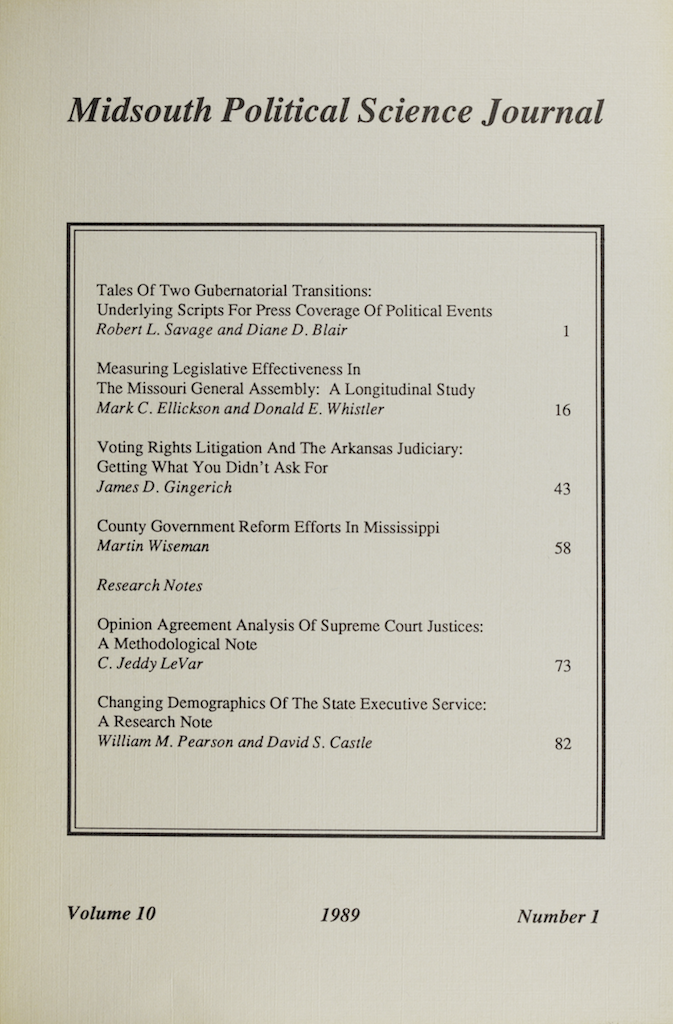Changing Demographics Of The State Executive Service: A Research Note
DOI:
https://doi.org/10.15763/issn.2374-7781.1989.10.0.82-86Abstract
Demographic data on public employees address two prominent public administration issues: the representativeness of bureaucracy and the qualifications of its personnel. A “representative bureaucracy” reflects the social characteristics of the population and is measured by the access of social groups to government jobs. The relationship between representative bureaucracy and democracy is well established in the public administration literature. A common assertion is that representative bureaucracy reflects attitudes, values, and policy preferences of society, thereby promoting administrative responsiveness to public needs (Meier 1987, 180). Others argue that public confidence increases in political institutions as they become more representative of the population they serve, and the perception of bureaucracy as open to major social groups, particularly women and ethnic minorities, has a necessary symbolic, legitimizing, and stabilizing effect on political systems (Krislov 1974, 64; Krislov and Rosenbloom 1981, 71). A highly qualified, competent, and professional workforce is an equally laudable societal value. It is gauged by the educational attainments and relevant experience of public servants. This study, reporting the demographic composition of the executive service in selected states, has implications for both of these salient concerns.Downloads
Published
Issue
Section
License
Authors who publish with American Review of Politics agree to the following terms:
The Author retains copyright in the Work, where the term “Work” shall include all digital objects that may result in subsequent electronic publication or distribution.
Upon acceptance of the Work, the author shall grant to the Publisher the right of first publication of the Work.
The Author shall grant to the Publisher and its agents the nonexclusive perpetual right and license to publish, archive, and make accessible the Work in whole or in part in all forms of media now or hereafter known under a Creative Commons Attribution-NonCommercial-ShareAlike 4.0 License or its equivalent, which, for the avoidance of doubt, allows others to copy, distribute, and transmit the Work under the following conditions:
Attribution: other users must attribute the Work in the manner specified by the author as indicated on the journal Web site;
Non-Commercial: the materials may not be used for commercial purposes;
Share Alike: If you remix, transform, or build upon the material, you must distribute your contributions under the same license as the original.
with the understanding that the above condition can be waived with permission from the Author and that where the Work or any of its elements is in the public domain under applicable law, that status is in no way affected by the license.
The Author is able to enter into separate, additional contractual arrangements for the nonexclusive distribution of the journal's published version of the Work (e.g., post it to an institutional repository or publish it in a book), as long as there is provided in the document an acknowledgement of its initial publication in this journal.
Authors are permitted and encouraged to post online a pre-publication manuscript (but not the Publisher’s final formatted PDF version of the Work) in institutional repositories or on their Websites prior to and during the submission process, as it can lead to productive exchanges, as well as earlier and greater citation of published work (see The Effect of Open Access). Any such posting made before acceptance and publication of the Work shall be updated upon publication to include a reference to the Publisher-assigned DOI (Digital Object Identifier) and a link to the online abstract for the final published Work in the Journal.
Upon Publisher’s request, the Author agrees to furnish promptly to Publisher, at the Author’s own expense, written evidence of the permissions, licenses, and consents for use of third-party material included within the Work, except as determined by Publisher to be covered by the principles of Fair Use.
The Author represents and warrants that:
the Work is the Author’s original work;
the Author has not transferred, and will not transfer, exclusive rights in the Work to any third party;
the Work is not pending review or under consideration by another publisher;
the Work has not previously been published;
the Work contains no misrepresentation or infringement of the Work or property of other authors or third parties; and
the Work contains no libel, invasion of privacy, or other unlawful matter.
The Author agrees to indemnify and hold Publisher harmless from Author’s breach of the representations and warranties contained in Paragraph 6 above, as well as any claim or proceeding relating to Publisher’s use and publication of any content contained in the Work, including third-party content.


